 Hanoi to Sapa Mountains: March 17 – 21, 2012
Hanoi to Sapa Mountains: March 17 – 21, 2012
March 17: Hanoi to Lao Cao
We go back to our hotel to rest, have dinner and get ready by 8:00pm for our transport to the train station. Once we get there , the agent from Vietnam Travel takes our vouchers to exchange for real tickets and waits until it’s boarding time and accompanies us all the way to our cabins. I’m glad for this service as it is confusing to find our carriage. We cross the train tracks and walk a distance before finally finding the Fansipan carriage.


I had booked and paid $149 usd per person roundtrip for a soft sleeper 4-berth cabins air conditioned to have privacy. Our cabin is adequate and comfortable; they provide two bottles of water, bananas and peanuts for snack. There is one bathroom which is shared by all passengers in this carriage. The ride is rough, noisy and feels like a roller coaster. At times, it rocks back and forth, side to side feeling like a lullaby rocking you to sleep; and actually feels good. Bottom line, it’s hard to get a good sleep on this over 8-hour overnight train ride to Lao Cao.
March 18: Lao Cao -Bac Ha Market- Sapa
At around 5:00am we hear a banging noise on our door, it’s the train steward waking passengers. He asks if we want coffee, and I say yes. He hands our coffee and stands by our door whispering some words which I cannot understand. He asks repeatedly, and then it becomes clear he wants to get paid for our coffee. I thought it is included in our train fare, but hey it’s only $1 usd and I gladly paid.
While planning our trip to Vietnam, I timed our arrival in Lao Cao to be on a Sunday, the only day the Bac Ha market is held. Upon arrival in Lao Cao we are met by our tour guide, Queyn, a very petite young woman who speaks very good English. Instead of having breakfast by the train station like many tourists do, we drive straight to Lao Cao to get there early. Our tour guide is very clever, and suggests we do some things in our itinerary in reverse to avoid crowds. So after breakfast we head 1st to Ban Pho, a Flower H’Mong village. It’s a short and manageable walk and we see typical village houses, children playing , a family going about their usual daily routine.

BanPho, a Flower H'Mong Village
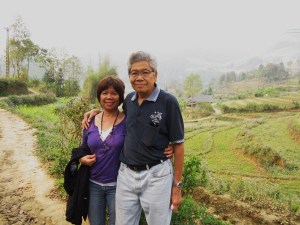
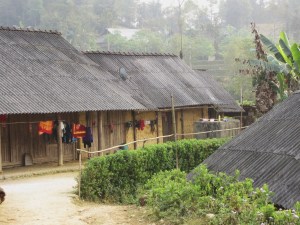
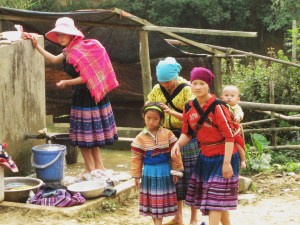 My eyes are drawn to a very colourful wedding tent, which the family builds to use for ceremony and reception when a family member gets married. Queyn explains, men seat on one side and females on the other. We also learn that only men are allowed to drink, dance and sing at wedding parties. I guess women have to stay sober to assist their spouse in getting back home, uhmm, not a bad idea and makes sense, don’t you agree?
My eyes are drawn to a very colourful wedding tent, which the family builds to use for ceremony and reception when a family member gets married. Queyn explains, men seat on one side and females on the other. We also learn that only men are allowed to drink, dance and sing at wedding parties. I guess women have to stay sober to assist their spouse in getting back home, uhmm, not a bad idea and makes sense, don’t you agree?

A Wedding Tent used for ceremony & reception
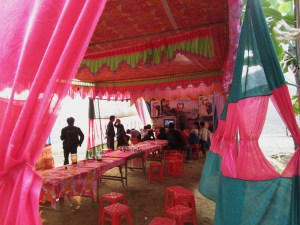
I love taking children photos, but Queyn tells me the village people usually don’t want photos of their child being taken. It symbolizes taking away their soul. So I should take them only from a distance using a telefoto or ask permission first. I managed to take few stolen shots.
 Bac Ha is located northeast of Lao Cao province, near the mountainous highlands and the Chinese border. It hosts the largest and most colourful market in the area and attracts different minority tribes such as Flower H’mong, Black Dao, Tay, Pu La and others from the surrounding hill tribes. Tourists flock here as well, to see and experience what this place is all about, but are mostly ignored by the locals. They are more focused on their business, to trade and barter. It appears the market is just not for buying and selling, but also for cultural and social interaction.
Bac Ha is located northeast of Lao Cao province, near the mountainous highlands and the Chinese border. It hosts the largest and most colourful market in the area and attracts different minority tribes such as Flower H’mong, Black Dao, Tay, Pu La and others from the surrounding hill tribes. Tourists flock here as well, to see and experience what this place is all about, but are mostly ignored by the locals. They are more focused on their business, to trade and barter. It appears the market is just not for buying and selling, but also for cultural and social interaction.

Bac Ha, a minority market
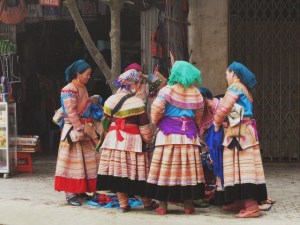
Flower H'Mong Tribe in their colorful dress
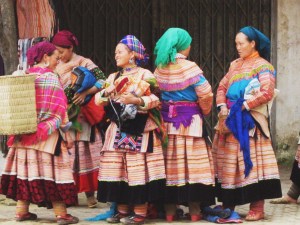
The Flower H'Mong women socializing
You’ll find just about everything is sold here: live stocks and farm animals. Horses are use mainly for carrying heavy loads; dogs either for meat or as pets; birds as pets, the singing ones being the most expensive selling for over $50 usd.
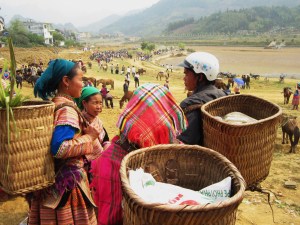
Horses and Birds are sold in this area


 Up on the hill is a big crowd of buffalos and locals who appear to be negotiating. Average price for a buffalo is $1,000 usd. We spot a “white buffalo” or an Albino, least desirable as it cannot endure working under the sun for very long time, and therefore commands a lower price. Farther down, are chickens, pigs and cats.
Up on the hill is a big crowd of buffalos and locals who appear to be negotiating. Average price for a buffalo is $1,000 usd. We spot a “white buffalo” or an Albino, least desirable as it cannot endure working under the sun for very long time, and therefore commands a lower price. Farther down, are chickens, pigs and cats.
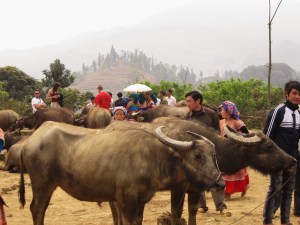
Water Buffalos

 There is a huge section for clothing, handicrafts, silver jewelries and embroidered items such as purse, pillow covers, blankets. A haven for tourists who like to shop for souvenirs.
There is a huge section for clothing, handicrafts, silver jewelries and embroidered items such as purse, pillow covers, blankets. A haven for tourists who like to shop for souvenirs.
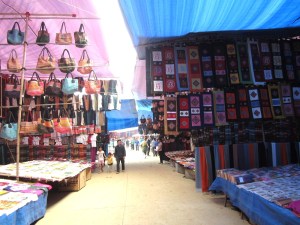
Clorhing & Handicraft section
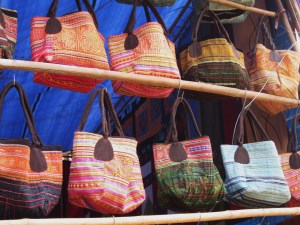

 Our nose leads us to big section of food stalls where many locals are eating. You smell and see all kinds of cooking: grilled meat, pork-stew with innards and all its parts on gigantic pots, blood sausage, soups like “Pho”, sticky rice, corn pudding, and fresh herbs are all here. The sights and aroma, both inviting & pungent are fascinating, and overwhelming and evoke mixed reaction from tourists. Some are repulsed while others get hungry going for it and get rewarded with good culinary experience. As TV hosts of “Bizarre Foods” Andrew Zimmerman always say, “If it looks good, eat it”.
Our nose leads us to big section of food stalls where many locals are eating. You smell and see all kinds of cooking: grilled meat, pork-stew with innards and all its parts on gigantic pots, blood sausage, soups like “Pho”, sticky rice, corn pudding, and fresh herbs are all here. The sights and aroma, both inviting & pungent are fascinating, and overwhelming and evoke mixed reaction from tourists. Some are repulsed while others get hungry going for it and get rewarded with good culinary experience. As TV hosts of “Bizarre Foods” Andrew Zimmerman always say, “If it looks good, eat it”.
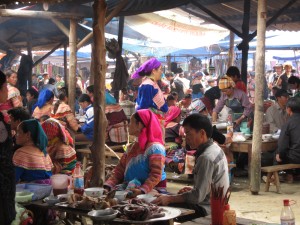
The Food Stalls Section

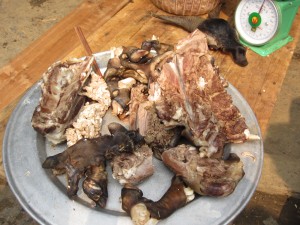
Walking thru the market we see many women from the Flower H’Mongs tribe wearing their most attractive & colorful dress and bandanas. They dominate the number of minorities in this market, so you’ll see them throughout presenting many photographic opportunities for enthusiasts, including me. I’m so glad I still have extra memory cards, for I’ve already used up two 4- gigabyte memory cards.
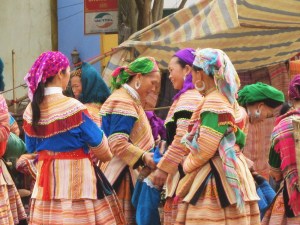
Very colorful Flower H'Mongs dress
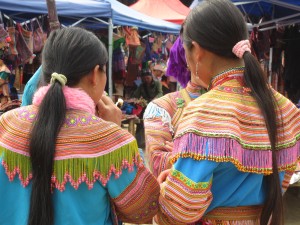


 As we leave the market, I spot an area and calls my husband’s attention, “Look, you can have your hair cut here, too”.
As we leave the market, I spot an area and calls my husband’s attention, “Look, you can have your hair cut here, too”.
Next we go visit Hoang A Tuong palace, considered by Hmong people as their King in the French colonial time. Over many decades, the palace still retains its original architecture of the old time . Now it houses a souvenir shop inside. Our guide tells us the King had more than 10 concubines, each with their own separate rooms in the palace. I can’t help but wonder how the King managed his schedule? There are only 7 days to a week, isn’t it? Go figure…

Hoang A Tuong palace
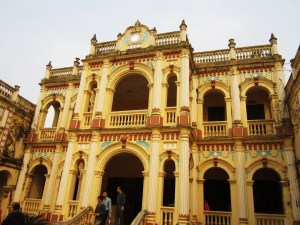

Souvenir shop inside the Palace
Winding down our day and as we head to Sapa, we make one last stop at the Vietnam/Chinese border. The two countries are separated only by a short bridge; and Vietnamese people shopping for cheaper clothes in China, only need special permission to cross the border. As the hot sun has taken its toll on us, we are eager to cool off by having tofu served with ginger honey & crushed ice from a local vendor. While seating on a bench, we enjoy our treat.

Vietnam/Chinese Border


Ramon with Queyn, our tour guide
The drive from Bac Ha to Sapa takes about 2 ½ hours, and a good opportunity to take a nap . But I stayed awake to watch the scenic and beautiful view of the rice terrace fields as we ascend on curvy, winding roads of Sapa mountains.
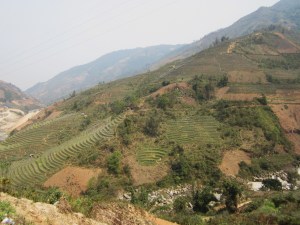
View on the way to Sapa Mountain


We are lucky, again, to have good weather during our stay in Sapa. However, some of our days are too hot and find myself wishing we have instead, a cool weather as we predicted in Sapa, low to mid 50’s. Based on TA trip reports and weather forecasts, we expect Sapa’s weather to be very cold, and packed accordingly making us ill-prepared for the hot weather. The couple from Italy who went on Halong Bay cruise with us, has experienced the opposite. During their visit to Sapa, few days before the Halong Bay cruise, the weather is very cold, foggy, misty and no visibility. There are no views, no pictures to take! Truly a shame for this couple has fancy camera equipments and tripods looking like professionals, but are not, just their hobby. At least, Halong Bay, with its own beauty, gave them many opportunities to take great photos.
We arrive in Sapa town and check in at Sapa Eden Hotel where I made booking for a junior suite for 2 nights with Agoda.com. The hotel is located on the edge of town close to the entrance of CatCat village. Our room is spacious, with a small balcony and overlooks the valley. It has sofas for seating and relaxing after a long day of sightseeing and shopping. The hotel manager, Mr Dung is nice and very accommodating.
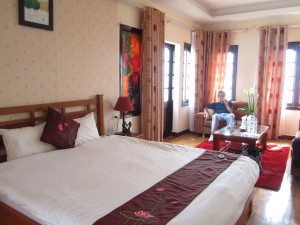
Our junior suite at Sapa Eden Hotel
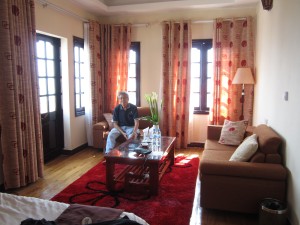
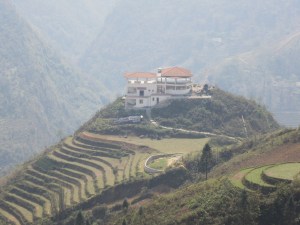
View from our hotel room
It is quiet and away from Black H’Mong peddlers, yet close enough to walk to the local market and many restaurants. The town is dominated by Black H’Mong tribe, the largest minority in Sapa, and you see them everywhere very persistent in selling you souvenirs. They don’t take no for an answer, follow you for a while and try to make conversation. They speak good English and usually ask “Where you’re from?”. This encounter happens everytime you’re out on the street; walking, shopping, even when you’re eating at a restaurant.

Main street where our hotel is on
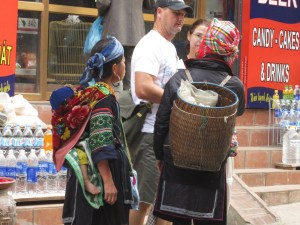
Black H'Mong women selling souvenirs

Some Black H'Mong women will pose for you
After settling in, we walk into town to find where we can hire motorbikes (as passengers) with driver & tour guide to take us to Lao Chai Tavan village. One of the things we really appreciate while in Vietnam is the availability of motorbikes to use for sightseeing. As I’ve alluded to many times in my blog, my husband can’t walk very far distances due to knee & hip problems. Riding as passengers on motorbikes allow us to visit many attractions. The 1st agency gives us a quote of $35 usd per person, too expensive so we walked out. For comparison, a private tour on car to Lao Chai-Tavan-Giang Mai costs $55 usd for two, but we prefer to go on motorbikes. About two doors down, at Son Ha or Song Pa Hotel, I’m very happy to find a much lower price. The total cost for 2 people, with one of the drivers of the motorbike acting as our guide, is only 300,000 VND ( $15 usd). I can’t believe my ears so I ask again, for 2 or for one? What a deal, sold! What time will you pick us up at our hotel tomorrow morning?
March 19
Promptly at 8:30am, Thung our driver/guide shows up at Sapa Eden Hotel with another motorbike. By this time, me & Ramon, are now “professional” motorbike riders. We head out of town center, make a stop at a view point to take pictures of Sapa town. Located 38km from Lao Cai City, Sapa is a mountainous district of Lao Cai Province. Sapa District is very well-known with Sapa Townlet, a beautiful and romantic resort.At the height of 1,600m above sea level, the average temperature of the area is 15-18°C. The first thing you notice when approaching the resort town are some detached wooden mansions and villas perched on a hill top or hillside, behind thick pine forests and almost invisible on a foggy morning. Old and new villas with red roofs now appear and now disappear in the green rows of trees, bringing the town the beauty of European towns.
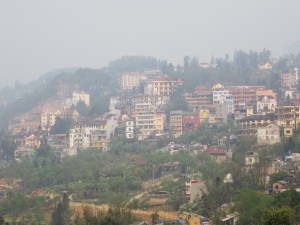
Sapa Town from a viewpoint
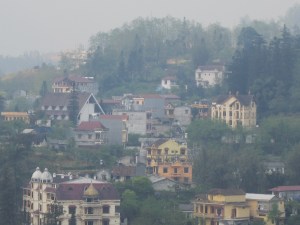
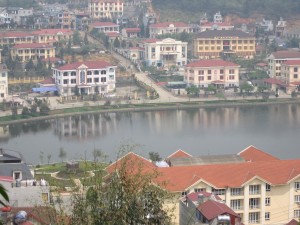
We then get into the paved main highway of Sapa mountain for a thrilling, exciting, motorbike ride as we follow its winding road, sharp turns and curves every 30 to 40 feet from its high elevation. With so much adrenalin, I did not even fear or think what if we skid off road and fall down the cliff or get hit by a car or bus? Along the way, we make stops at several view points where groups of Black H’Mongs hang around to sell souvenirs to tourists. It’s quite common among the minority hill tribes for girls as young as 12 years old to have babies, and witness many.

Thung, our motorbike driver & tour guide
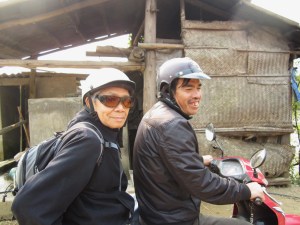
Ramon with his motorbike driver
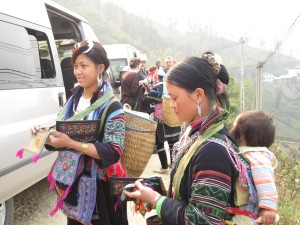

After riding for about 9 km, we reach the entrance to Lao Chai, a village of black H’Mong ethnic tribe, and begin our descend into a mix of dirt and partly asphalt roads. We pass by tourists trekking on foot and glad we’re not, as we can see how far down we have to go to reach the center of Lao Chai village. Going downhill is a bumpy ride, and we swerve a few times to avoid potholes, but did not mind as our attention is focused on admiring the amazing view of terraced-rice fields. The visit to the village gives us a glimpse into their rural life and living.
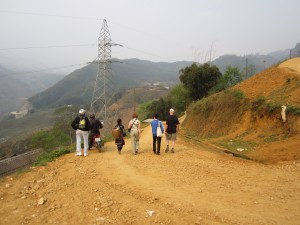
Going down to Lao Chai Village

View of Lao Chai Village showing Homestays

Farmers working on rice fields

One of the homes in the Lao Chai village

A sighting of "Baby Pigs"
We stop at an elementary school, with kids ranging from 4 to 6 yrs old, seemingly unfazed by tourists. They continue their work, and occasionally look up and pose for our camera. There’s a donation box for the school in the front that’s hard to miss. According to Thung, our guide who’s wife is a school teacher, school is provided to all children of the village, including books and all supplies. Sadly, many children do not go to school, and some are motivated only with a promise they will get candies from visiting tourists. His wife is disappointed that most parents do not encourage their kids to go to school.
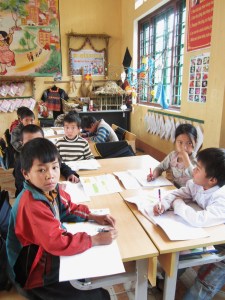
School in Lao Chai Village
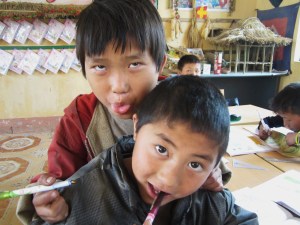
School children posing for our camera
Crossing a small bridge over Muong river takes us to Ta Van village, home to Red Dzao, set in the picturesque valley of Muong Hao. In both villages, there are many restaurants and souvenir shops for tourists to part with their money. We also stop at this place with fashionable displays of their native outfits; and where we pay to cross the “Rattan Hanging Bridge”, but ends up just posing as the bridge looks unsafe to us.
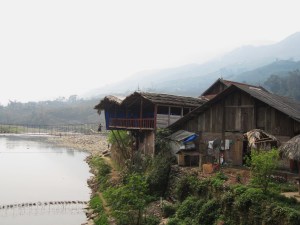
A house in Ta Van Village

There are few markets like this in the village.

Fashionable display of their native outfits

I dare you cross this "Hanging Bridge
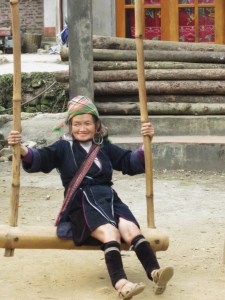
Our tour guide stops at a museum so we can look at some photo displays. Again, we are approach by few elderly Black H’Mong women who are persistent in selling their handmade souvenirs like a phone holder, small purse, key chains, etc. There’s really nothing I’m interested, so out of pity I hand her $1 usd. The rest of them surround me and say, “How about me?” The photo displays inside the museum show a an entirely different, and beautiful view of the rice fields during harvest season. Photos during festival and wedding are also on display. These photos make me want to return to Sapa and see the change in its landscape during different seasons.

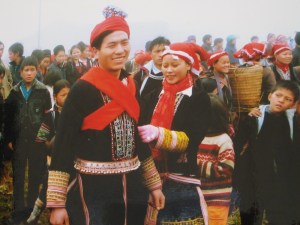
Taken during a Wedding
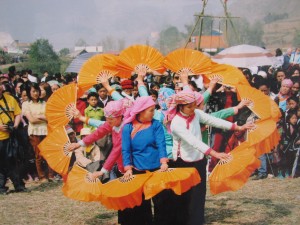
Taken during a Festival
Our tour ends at 11:00am and we are dropped off by the entrance of the HamRong mountains per my request. I will attempt to go up as far as I can alone, for there is no way Ramon would be able to handle the steps going up. He waits for me at the base and I promise to return in an hour. I read on average, it takes one to 2 hours to get to the top depending on the person’s physical condition. A series of steps takes you up to different levels and points of interest all the way to the top. It is evident after climbing the stairs to the Orchid Garden that I don’t have the stamina to get much farther. It’s also disappointing to see the orchids are not in full bloom. I want to at least get to the European Garden before I quit, but somehow could not find the way. Ramon is so surprised I’m back too soon. Oh well, I tried.
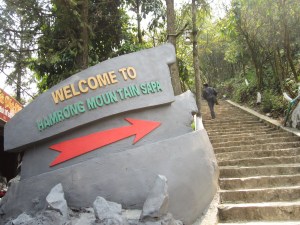

Orchid Garden, the 1st stop on HamRong Mountain
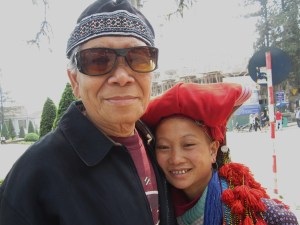
A Red Dzao woman hope by posing w/ Ramon will make him buy souvenirs from her
We decide to have lunch at Sapa Rooms Boutique Hotel restaurant. Yesterday, was our first meal here and ordered too much; papaya salad, spring rolls , chicken cooked in chile & lime, pork stewed in tamarind & coconut milk on a clay pot. This time we order light, and try their famous banana flower salad w/ chicken, a pho with meatballs and chicken rice soup. Everything we’ve ordered from this place is delicious, so it’s our favorite restaurant in Sapa and only few minutes walk from our hotel. On the way to our hotel we pass by many places that offer foot and body massage. What is wrong with me? Why am I not interested? It must be the hot weather making it not conducive for me. It’s nice to be back in our hotel, and we take some nap.

A Catholic Church in center of Sapa Town

Decor at Sapa Rooms Boutique Restaurant
At 4:00pm we head back into town to shop for North Face jackets (NF). What’s so special about buying NFJ in Vietnam? Well, unfamiliar with this name brand my niece informs me these same brand jackets (made in Vietnam) sell in REI stores in the US for $100 to $125 usd; but cost only around $25 usd in Vietnam if you know how to bargain. She requested we buy 2 jackets for her and her husband. Unlike in Hoi An, there are so many shops in Sapa that sells NF jackets. Great, we will have many size and color selections to choose from. Wrong! We find out, as we go from one store to the other, there are many shops that make the NF jackets and their sizes are not standard. Some are made to fit Vietnamese people, and others are for Western standards. In one store I’m medium size, but requires a large or even extra large in another store. It quickly become frustrating and difficult to find the color, right style and size. In as much as I wish to get one jacket as gift for every member in my family (about 18), we are able to buy only a total of 5 NF jackets.
March 21: Sapa-Lao Cao-Hanoi
Today is our last day in Sapa and we have an entire day to explore before we get back to Lao Cao train station. I booked our transport to the train station with Sapa Eden Hotel for $3 usd per person for a group transfer (minivan).
For a change, we do not have any scheduled tour this morning. So we get to sleep-in late, and take it easy and slow to get ready. It’s also foggy and cool, but anticipate the day will clear up and get warmer later as in the last 2 days. At last, we get to use our walking sticks we bought in the US to use for trekking in Sapa.

Cat cat Village


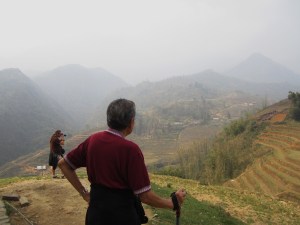

We have all day to trek down to Cat Cat village for we have nothing else plan for the rest of the day. Cat Cat is a village of the black H’Mong, about 2 km from town, and cost 20,000 VND per person. The village is near the bottom of a valley right at the foot of Fansipan mountains, surrounded by high mountains and terraced rice paddies on slopes. The trek (no need for a guide) takes about 90 minutes and goes down thru a series of concrete steps with no handrails. This is where we find the best use of our walking sticks, lending much needed support for our knees as we take each steps down.
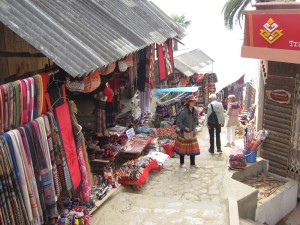


Colorful blankets made by women
At the end is a waterfall and a nearby small theater where we watch a free traditional dance show.
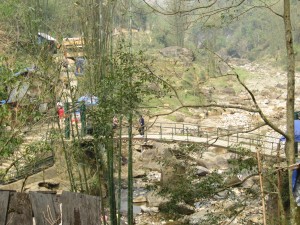

 We take a motorbike up to our hotel and paid 25,000 vnd each. We leave our hotel to go back to Lao Cao train station. We take the overnight train and arrived in Hanoi at 4:30am. Back at HE Diamond hotel, we take a shower, have breakfast, take our luggage and wait for our transport to Hanoi airport. Our hotel has plenty of comfortable place to seat & wait.
We take a motorbike up to our hotel and paid 25,000 vnd each. We leave our hotel to go back to Lao Cao train station. We take the overnight train and arrived in Hanoi at 4:30am. Back at HE Diamond hotel, we take a shower, have breakfast, take our luggage and wait for our transport to Hanoi airport. Our hotel has plenty of comfortable place to seat & wait.

Waiting for our airport transport at HE hotel
After 22 days, visiting Cambodia and Vietnam our happy days are over and we flew back home to Los Angeles. We take with us many wonderful memories of a great, enjoyable, and unforgettable trip.
 Hanoi to Sapa Mountains: March 17 – 21, 2012
Hanoi to Sapa Mountains: March 17 – 21, 2012





















































































We have really enjoyed your blog . You both have a great sense of adventure ! Lovely photos and lots of detail which have made us very excited about our trip soon with a similar itinerary . I am inspired by your example to try my first blog . This is a lot to live up to though .
Happy travels x
LikeLike
Dear mcternan,
You will love Sapa! Be sure and go to Bac Ha Market which is only held on Sundays, if not the next one you should aim for is Coc Ly market. It’s smaller but i read still quite nice and it’s held on Tuesday.
Glad you enjoy reading my blog. You should try it! This is my 1st time to blog and i’m hooked. I must say it is very time consuming and best you keep a journal to remember all the details.
Have a nice trip,
Lena
LikeLike
a beautiful experience of another culture, sceneries, and people…
LikeLike
hi belle,
yes indeed, and it’s nice to be able to share with others. cheers!
LikeLike
It’s indeed a tremendous narrative with beautiful pictures with it. Congratulations again for this much revered creativity. I felt like I was there with you.
More power to you Ade as you embark repeatively on this blog!!!!
LikeLike
Hi Its,
Thanks for your kind words and I’m glad I succeeded in taking you along with us on our trip thru my blogs. I may continue to write more blogs on other things, if I know there will be people interested in reading them.
Ade
LikeLike
Again, you never stop to amazed me…how detailed and full of enthusiasm in describing your travels and experiences with people, food and culture.. It makes me want to go there too. I also have the impression that it is very safe and secure places to visit Vietnam and Cambodia.. I jlove your Hanong Bay but i think “Sapa Mountains” tops.
More power to “ramonadetravels”.
AL
LikeLike
Hi AL,
Thank you for taking the time to read my blogs. Yes, it is safe to go to Cambodia and Vietnam. I think you and Eves should go, it will be fun!
Ade
LikeLike
Lena, WOW! You have definitely missed your calling! You have all these travel hosts beat by a mile. Its probably because as a woman you see and commented on the colors and savory nuances men usually miss or dont “get”! I d keep reviewing the blog daily it s so intriguing. Lucky us! Lana P.S. Ill send it to dad,who knows I may get there yet!
LikeLike
Dearest youngatheart, Thank you so much for taking the time to report in such detail! My biggest regret was not making it to Sapa!!! (next time…) I really enjoyed your report and the beuatiful photos – thank you.
Sue.
LikeLike
Lena So many visual delights! With your designers eye for color and and beauty , I will revisit your blog often just to smile! Far better than any travel show Ive seen.
LikeLike
Dear Lana,
Thank you so much for your compliments. I’m glad my blogs are worthy of your precious time. It takes one to know one…
LikeLike
Great blog, and the small details really helped!
LikeLike